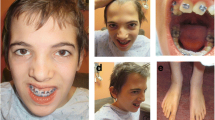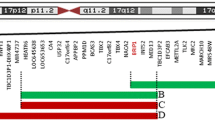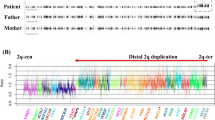Abstract
The 9p deletion syndrome, which was defined in a detailed way in the previous studies, was characterized by various clinical features such as psychomotor retardation, dysmorphic features and genital anomalies. In contrast to 9p deletion syndrome, 20p duplication was rarely reported in the literature with only a few case reports. Regarding the combination of 9p deletion syndrome and 20p duplication, we found that it was reported in only four patients. In the current study, we aimed to investigate a rare chromosomal rearrangement, partial monosomy 9p and trisomy 20p which was observed in two patients with mirror hand movements. The mirror hand movements was influenced by the combination of genetic and environmental factors. While some cases have been associated with mutations in the DCC, NTN1, RAD51, and DNAL4, there were many cases where the genetic basis of mirror hand movements remained unexplained. There was no alteration detected in genes that were previously known as a cause of mirror hand movement in our patients. This new finding could potentially be attributed to the dosage effect of genes within the 9p deletion or 20p duplication regions or to the genes disrupted within the breakpoint region. Future research focusing on the genes within this genomic locus may hold the potential to uncover novel etiologic reasons for mirror hand movements.


Similar content being viewed by others
Data availability
All data generated or analyzed during this study are included in this article. Further inquiries can be directed to the corresponding author.
References
Hauge X, Raca G, Cooper S, May K, Spiro R, Adam M et al (2008) Detailed characterization of, and clinical correlations in, 10 patients with distal deletions of chromosome 9p. Genet Med 10(8):599–611. https://doi.org/10.1097/gim.0b013e31817e2bde
Swinkels ME, Simons A, Smeets DF, Vissers LE, Veltman JA, Pfundt R et al (2008) Clinical and cytogenetic characterization of 13 Dutch patients with deletion 9p syndrome: Delineation of the critical region for a consensus phenotype. Am J Med Genet A 146A(11):1430–1438. https://doi.org/10.1002/ajmg.a.32310
Chen G, Xiong S, Zou G, Wu F, Qu X, Alawbathani S et al (2022) A 6.3 mb maternally derived microduplication of 20p13p12.2 in a fetus with brachydactyly type D and related literature review. Mol Cytogenet 15(1):6. https://doi.org/10.1186/s13039-022-00584-3
Sidwell RU, Pinson MP, Gibbons B, Byatt SA, Svennevik EC, Hastings RJ et al (2000) Pure trisomy 20p resulting from isochromosome formation and whole arm translocation. J Med Genet 37(6):454–458. https://doi.org/10.1136/jmg.37.6.454
Thomas MA, Duncan AM, Bardin C, Kaloustian VM (2004) Lissencephaly with Der(17)t(17;20)(p13.3;p12.2)mat. Am J Med Genet A 124A(3):292–295. https://doi.org/10.1002/ajmg.a.20373
Venditti CP, Hunt P, Donnenfeld A, Zackai E, Spinner NB (2004) Mosaic paternal uniparental (iso)disomy for chromosome 20 associated with multiple anomalies. Am J Med Genet A 124A(3):274–279. https://doi.org/10.1002/ajmg.a.20430
Chaabouni M, Turleau C, Karboul L, Jemaa LB, Maazoul F, Attié-Bitach T et al (2007) De novo trisomy 20p of paternal origin. Am J Med Genet A 143A(10):1100–1103. https://doi.org/10.1002/ajmg.a.31704
Freitas ÉL, Gribble SM, Simioni M, Vieira TP, Silva-Grecco RL, Balarin MA et al (2011) Maternally inherited partial monosomy 9p (pter → p24.1) and partial trisomy 20p (pter → p12.1) characterized by microarray comparative genomic hybridization. Am J Med Genet A 155A(11):2754–2761. https://doi.org/10.1002/ajmg.a.34168
Meloni Vde F, Piazzon FB, Soares Mde F, Takeno SS, Christofolini DM, Kulikowski LD et al (2012) Cytogenomic characterization of an unexpected 17.6 mb 9p deletion associated to a 14.8 mb 20p duplication in a dysmorphic patient with multiple congenital anomalies presenting a normal G-banding karyotype. Gene 496(1):59–62. https://doi.org/10.1016/j.gene.2012.01.007
Hoo JJ, Fischer A, Fuhrmann W (1982) Familial tiny 9p/20p translocation: 9p24 the critical segment for monosomy 9p syndrome. Ann Genet 25:249–252
Mohamed AM, Kamel AK, Eid MM, Eid OM, Mekkawy M, Hussein SH et al (2021) Chromosome 9p terminal deletion in nine Egyptian patients and narrowing of the critical region for trigonocephaly. Mol Genet Genomic Med 9(11):e1829. https://doi.org/10.1002/mgg3.1829
Vialard F, Ottolenghi C, Gonzales M, Choiset A, Girard S, Siffroi JP et al (2002) Deletion of 9p associated with gonadal dysfunction in 46,XY but not in 46,XX human fetuses. J Med Genet 39(7):514–518. https://doi.org/10.1136/jmg.39.7.514
Griggs BL, Ladd S, Saul RA, DuPont BR, Srivastava AK (2008) Dedicator of cytokinesis 8 is disrupted in two patients with mental retardation and developmental disabilities. Genomics 91(2):195–202. https://doi.org/10.1016/j.ygeno.2007.10.011
Sivasankaran A, Kanakavalli MK, Anuradha D, Samuel CR, Kandukuri LR (2016) Ring chromosome 9 and chromosome 9p deletion syndrome in a patient Associated with Developmental Delay: a Case Report and Review of the literature. Cytogenet Genome Res 148(2–3):165–173. https://doi.org/10.1159/000445862
Méneret A, Trouillard O, Dunoyer M, Depienne C, Roze E, Congenital Mirror M (2015) 12 [updated 2020 Sep 24]. In: Adam MP, Mirzaa GM, Pagon RA, Wallace SE, Bean LJH, Gripp KW, Amemiya A (eds) GeneReviews® [Internet]. University of Washington, Seattle, Seattle (WA). 1993–2023. PMID: 25763452.
Ahmed I, Mittal K, Sheikh TI, Vasli N, Rafiq MA, Mikhailov A et al (2014) Identification of a homozygous splice site mutation in the dynein axonemal light chain 4 gene on 22q13.1 in a large consanguineous family from Pakistan with congenital mirror movement disorder. Hum Genet 133(11):1419–1429. https://doi.org/10.1007/s00439-014-1475-8
Demirayak P, Onat OE, Gevrekci AÖ, Gülsüner S, Uysal H, Bilgen RS, Doerschner K, Özçelik TS et al (2018) Abnormal subcortical activity in congenital mirror movement disorder with RAD51 mutation. Diagn Interv Radiol 24(6):392–401. https://doi.org/10.5152/dir.2018.18096
Poisson A, Lesca G, Chatron N, Favre E, Cottin V, Gamondes D et al (2019) 12q13.12q13.13 microdeletion encompassing ACVRL1 and SCN8A genes: clinical report of a new contiguous gene syndrome. Eur J Med Genet 62(11):103565. https://doi.org/10.1016/j.ejmg.2018.10.017
Funding
This research did not receive any specific grant from funding agencies in the public, commercial, or not-for-profit sectors.
Author information
Authors and Affiliations
Contributions
POC examined the patients, wrote and review the manuscript, prepared figures.
Corresponding author
Ethics declarations
Ethics approval and consent to participate
This study was performed in accordance with the Declaration of Helsinki Principles. The patient’s parents provided their written and informed consent for the publication of this case report and accompanying images. Ethical approval was not required for this study in accordance with local/national guidelines.
Competing interests
The authors declare no competing interests.
Additional information
Publisher’s Note
Springer Nature remains neutral with regard to jurisdictional claims in published maps and institutional affiliations.
Rights and permissions
Springer Nature or its licensor (e.g. a society or other partner) holds exclusive rights to this article under a publishing agreement with the author(s) or other rightsholder(s); author self-archiving of the accepted manuscript version of this article is solely governed by the terms of such publishing agreement and applicable law.
About this article
Cite this article
Ozyavuz Cubuk, P. New candidate region for mirror hand movements: two patients with terminal 9p deletion and 20p duplication. Mol Biol Rep 51, 243 (2024). https://doi.org/10.1007/s11033-023-09192-9
Received:
Accepted:
Published:
DOI: https://doi.org/10.1007/s11033-023-09192-9




